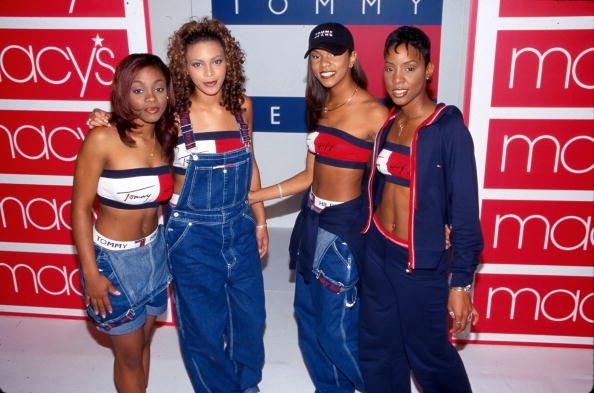Sisters in Style: 90s Hip-Hop Women and Their Trailblazing Trends

Musical group Destiny’s Child promoting Tommy Hilfiger Jeans.
The 1990s in North America was a golden era for hip-hop, not just in music but also in fashion. In the earliest years of the 90s, black women’s fashion was influenced by what black men were wearing. From baggy pants to crop tops and oversized, colourful, and bright jewellery, women like Lil Kim, Queen Latifah, Missy Elliot, and Aaliyah used these trends to exhibit individuality and cultural pride. This was not just a trend—it was a way to self-express and embrace their femininity and sexuality in a largely male-dominated industry.
Black women were at the centre of setting beauty and fashion trends during the 90s. From R&B divas to black models and actresses, women of colour introduced their creativity to the world. Aaliyah, known as the ‘Princess of R&B,’ shocked the world not just with her voice but also with her looks. She was recognised for her baggy clothes and sunglasses, creating an effortlessly aesthetic look that inspired girls all around the world. Her beauty and looks took her far in the industry, making her the first black woman in the music industry to be included in high-profile campaigns for designers such as Tommy Hilfiger.
Lil Kim introduced luxury fashion into hip-hop, inspiring black rappers and singers to embrace brands including Chanel, Versace, and Louis Vuitton. This was initially disliked by the luxury brands themselves, who saw it as tarnishing their image of exclusivity and prestige. Rooted in racism, they often claimed hip-hop culture was ‘too urban’ or ‘ghetto,’ clashing with their traditional marketing to wealthy white clientele. Nonetheless, these opinions didn’t stop the black community from wearing them. One of Lil Kim’s famous looks was the one-sleeve, purple sequined jumpsuit with a matching pasty that she wore to the 1999 VMAs—a look that still inspires many other artists today.
The 1990s also saw many black women start to use their hair as a statement of Black feminist power. It was a key element in the 1990s hip-hop fashion. Box braids, asymmetrical bobs, bold cuts, and knots—these hairstyles were a symbol of Black cultural expression.
Tracksuits, sneakers, and sportswear were also trendy in 90s hip-hop fashion. Many black women in the industry embraced streetwear, including Lisa ‘Left Eye’ Lopez from TLC. Her style was considered unique, wearing tomboy elements with quirky, colourful accessories, which reflected her fun and rebellious personality. She used fashion as a form of art and social expression. She also used fashion as a form of activism, for example, the famous look that was wearing a condom on her glasses or clothes to promote safe sex.
The fashion of 1990s hip-hop continues to resonate today, with many contemporary artists inspired by the bold looks of their predecessors. Oversized clothes and chunky jewellery, adorned with baby hair and other hairstyles that were popular in the 90’s remain so today, proving that the influence of the hip-hop is timeless.
In the 1990s, women in hip-hop not only used their creativity to dress fashionably but also as a tool of empowerment in the industry. They used their music and style to speak up about feminism, empowerment, independence, and self-expression in a male-dominated space. As Salt-N-Pepa said, they were ‘very necessary.’
By Stella Suarez, a student on the BA Journalism course at London College of Communication

